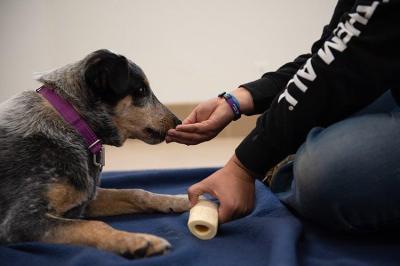
Dog Training Tips: Do's and Don'ts
Training a dog has numerous benefits for both you and your pooch. It is crucial for dogs to live happily with their family; it helps avoid unwanted behaviors, and it enhances a person's bond with their pet. Here are some basic dog training tips that cover do’s and don’ts to help set up you and your dog for success.
Do’s: How to effectively teach a dog
Let’s start with the dog training tips that we want to focus on doing:
Take baby steps. Have a clear idea of the behavior you want, and then break down the training required into small, attainable steps. Dogs learn better and enjoy training sessions more if they are successful and receive a reward. (Hey, who doesn’t?) If your dog doesn’t seem to be understanding what you’re asking, think about how you can make the training process easier. For example, if you are trying to teach the cue “down” and your dog just sits with a puzzled look on their face, start by rewarding your dog for simply lowering their head. Then increase the criteria from there.
Be consistent. Dogs are exceptionally good with details. To your dog, “sit,” “sit down,” and “Fido, sit” are different cues. With that in mind, make sure you are using exactly the same cue every time you ask your dog for a particular behavior. This strategy will help to avoid frustration on the part of you and your dog, and it will help your dog to understand what you are asking.
Use positive reinforcement. Positive reinforcement means rewarding your dog with treats, toys, praise, or whatever motivates them. Just like humans, dogs want some payoff for working. You can’t expect your dog to continually work for nothing. With that said, don’t overestimate how much praise means to your pet. (It’s great when your boss says “Good job,” but you also want that more tangible reward: your paycheck.) So be generous with the treat or toy rewards, especially at the beginning. Once your dog learns a behavior, you can adjust the reward schedule, but you’ll want to keep rewarding them periodically for a job well done.
Home starts with you
Seek help from a qualified professional for challenging behaviors. Dogs are complex beings and can exhibit behaviors that are beyond the scope of the average person to change. For challenging behavior, consult a qualified professional dog trainer or behaviorist.
Don’ts: Common dog training mistakes
And now for common dog training mistakes that we need to focus on not doing:
Don’t have your training sessions go longer than 20 minutes. Most dogs do best with training sessions of 10 to 15 minutes, so keep that in mind. Even five minutes of training can be very effective, especially if you are able to do it multiple times per day.
Don’t start training someplace with a lot of distractions. Like people, dogs learn more effectively if they aren’t distracted by a busy, noisy environment. For example, if you’re trying to teach your dog to sit, start the training in a quiet room in your home rather than at the neighborhood park, where you’d have to compete with animals, other people, and noises for your dog’s attention. Once your dog is consistently performing the behavior on cue, you can start to proof it. “Proofing” means practicing a behavior in different environments and situations until the dog generalizes the desired behavior and can do it anywhere, even with distractions.
Don’t use pain, fear, or intimidation when training. Always start with positive reinforcement when beginning to train your dog. Immediately jumping to methods that are not force free can result in a shaky relationship with your dog as well as results that are not as effective or long lasting. Training should be fun for the dog, not a scary and unpleasant experience.
Don’t get frustrated if you have a bad training session. Learning isn’t linear, and your dog might fluctuate in their progress from day to day. Stay calm, keep the big picture in mind, and do your best with the dog you have in front of you. If it’s not working, then stop the session and try again later or the following day.
Remember, this is about establishing long-term behavior for a long-term relationship. So take it slowly, and above all have fun.
